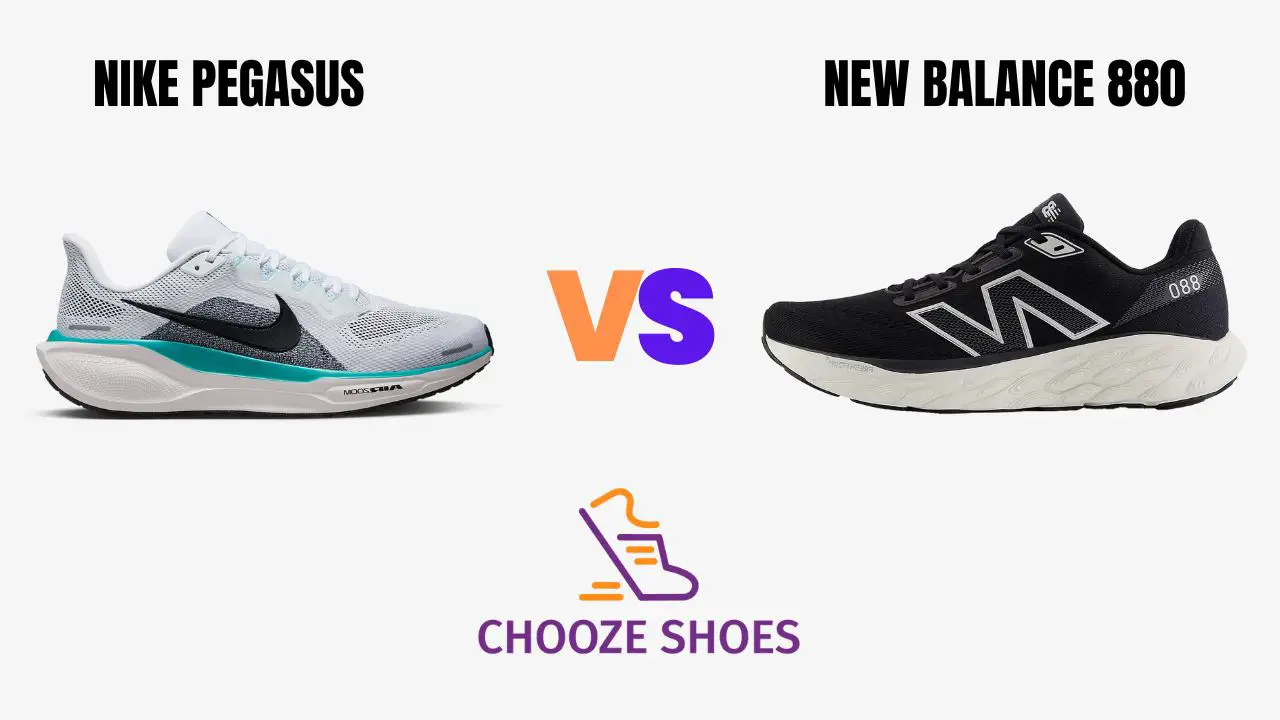Blog
Nike Pegasus vs New Balance 880: Detailed Shoe Comparison
If you’re wondering about the differences between the Nike Pegasus and New Balance 880, you’re in the right place! Both models – Pegasus 41 and Fresh Foam X 880 v14 – offer reliable daily cushioning yet meet different runner needs. This guide breaks down their technologies, performance, durability, and fit to help you choose.
Contents
Overall Comparison between Nike Pegasus and New Balance 880
When it comes to choosing the right running shoe, the Nike Pegasus 41 and New Balance 880 v14 are two of the most popular options on the market. Each of these shoes has its own unique features and benefits, making them both appealing to different types of runners.
That’s why we chose these 2 models for today’s comparison.
| Feature | Nike Pegasus 41 | New Balance 880 v14 |
|---|---|---|
| Price | $140 | $139 |
| Weight | 10 oz | 9.2 oz |
| Heel Drop | 10 mm | 8 mm |
| Cushioning | ReactX, Zoom Air | Fresh Foam X |
| Stability | Some stability | Very stable |
Cushioning and Responsiveness
| Feature | Nike Pegasus 41 | New Balance 880 v14 |
|---|---|---|
| Cushioning Technology | ReactX with Zoom Air | Fresh Foam X |
| Ride | Firmer, more responsive | Softer, plush |
| Best for | Short tempo runs | Long-distance comfort |
The heart of any running shoe lies in its midsole technology, and here, the Pegasus and 880 offer distinct experiences.
The Nike Pegasus primarily utilizes Nike React foam, a lightweight and durable foam that provides a soft, responsive ride. React foam is engineered to offer excellent energy return and cushioning, designed to absorb impact efficiently while propelling you forward.
This responsiveness makes the Pegasus versatile enough for both easy miles and slightly faster-paced efforts. While React foam is known for its durability, it strikes a balance, providing ample comfort without feeling overly plush or squishy, thus maintaining a degree of ground feel.
The New Balance 880 features Fresh Foam X, New Balance’s premium cushioning technology. Fresh Foam X is celebrated for its plush, cloud-soft feel, aiming to deliver maximum comfort and shock absorption.
In the 880 series, the Fresh Foam X is often configured to be slightly firmer than in some of New Balance’s other maximal cushioned shoes (like the 1080), providing a balanced and stable platform that still feels incredibly soft underfoot.
This dual-hardness approach in some Fresh Foam X implementations ensures a blend of softness and stability, appealing to runners who desire comfort without sacrificing support.
Stability and Fit Analysis
| Feature | Nike Pegasus 41 | New Balance 880 v14 |
|---|---|---|
| Stability | Moderate stability | Very stable |
| Fit Options | True to size; available in widths | True to size; available in widths |
Both shoes are designed with a focus on comfortable fit, but they cater to slightly different preferences.
The Nike Pegasus typically offers a snug, secure fit through the midfoot and heel, with a reasonably accommodating toe box. It aims for a “true to size” fit for most runners.
The upper is often a breathable engineered mesh, designed to provide a good lockdown without feeling restrictive. Some users note the Pegasus has a moderate stack height, which contributes to its versatility across different foot strikes and gaits.
The New Balance 880 is renowned for its accommodating fit, particularly for runners who require a bit more room. It often features a slightly wider toe box and a more generous overall volume, making it an excellent choice for individuals with “New Balance 880 wide fit” needs or those who prefer a less constricting feel.
The latest 880 v15 has a fit that is “slightly wider without being sloppy,” making it suitable for normal to slightly wider feet. New Balance’s commitment to offering multiple width options across many of its models further enhances its appeal for diverse foot anatomies.
Performance Suitability for Different Running Styles
- Easy Runs & Recovery: Both shoes excel here. The Pegasus offers responsive cushioning that makes easy miles feel smooth, while the 880’s plush Fresh Foam X provides exceptional shock absorption, ideal for “recovery runs.
- Long Runs: The substantial cushioning and durability of both make them strong contenders for longer efforts. The Pegasus’s balanced ride offers consistent comfort, and the 880’s recent maximal stack height ensures ample protection for high mileage.
- Tempo Runs/Faster Paces: The Pegasus, with its responsive React foam, can handle uptempo efforts reasonably well, offering a slight springiness. The 880, while becoming smoother with newer geometries, remains primarily an easy-effort shoe, generally less suited for very fast paces compared to more performance-oriented trainers.
- Beginner Runners: Both are excellent choices for “running shoes for beginners” due to their versatility, comfort, and protective cushioning. They offer a stable and forgiving platform to ease new runners into the sport.
User Feedback and Expert Opinions
Both shoes have garnered high marks, but user experiences can vary. The Nike Pegasus is often celebrated for its comfort and responsiveness, while the New Balance 880 is praised for its fit and plush ride, especially among long-distance runners.
Price Comparison and Value for Money
Pricing for both models hangs around $140, which offers a good balance when considering their features. While some may find the 890’s slightly lower price tag more attractive, others might see the durability of the Pegasus 41 as a better long-term investment.
Check more: Compare Nike Pegasus vs. Nike React Miler: Key Features & Specs
Key Features of Nike Pegasus 41 in Detailed
Cushioning Technology and Midsole Information
The Nike Pegasus 41 boasts a modern ReactX foam midsole. This technology provides a balanced cushioning experience that adapts to your foot strike, offering support without compromising responsiveness.
The addition of Zoom Air units in the forefoot and heel enhances the responsiveness, ensuring a pop-on toe-off that can be particularly beneficial for tempo runs.
Outsole Durability and Rubber Composition
This shoe features an outsole made of hard carbon rubber on the lateral crash pad and blown rubber on the medial side. This combination enhances durability while providing excellent traction on various surfaces. Its design makes it one of the few trainers that can withstand daily wear without significant degradation.
Breathability and Fit of the Upper
The upper of the Pegasus is crafted from engineered sandwich mesh, which not only adds breathability but also ensures a snug fit. The padded tongue prevents slide, while the heel counter is designed to avoid Achilles irritation.
Additionally, it comes in various widths, accommodating a wide range of foot shapes.
Weight and Heel Drop Specifications
Weighing in at 10 oz with a 10 mm heel drop, the Pegasus 41 is slightly on the heavier side, which is counterbalanced by its increased stack height. This configuration provides a firm yet cushy ride, suitable for casual and relaxed runs.
Check more: Comparison of Nike Pegasus vs Saucony Endorphin Shift 2
Key Features of New Balance 880 v14 in Detailed
Cushioning Technology and Midsole Information
In contrast, the New Balance 880 v14 utilizes Fresh Foam X technology. This midsole offers a plush cushioning experience, tailored more towards comfort than responsiveness, making it an excellent choice for longer runs where your feet crave comfort over speed.
Outsole Configuration and Rubber Materials
The outsole of the 880 features a combination of hard carbon rubber and softer blown rubber. While it provides adequate traction, it is not as durable as the Pegasus outsole, but it does contribute to a comfortable ride, especially at slower paces.
Upper Comfort and Breathability
The upper of the 880 is made from a soft mesh material. While it feels comfortable, some runners have noted that it can retain more heat compared to the Pegasus. However, it still provides a well-fitting shoe with multiple width options to accommodate various feet.
Weight and Heel Drop Specifications
The New Balance 880 is lighter at 9.2 oz with an 8 mm heel drop, making it a more agile option for some runners. The reduced weight may benefit those who prioritize speed over stability.
Check more: Do New Balance run big or small?
Important FAQs about Nike Pegasus vs New Balance 880
1. What running type is each shoe best suited for?
The Nike Pegasus 41 is ideal for short-tempo runs, while the New Balance 880 excels at longer, relaxed runs.
2. How do the cushioning technologies differ?
The Pegasus uses ReactX foam with Zoom Air units for responsiveness, while the 880 uses Fresh Foam X for maximum comfort.
3. Are there more width options available for either shoe?
Both shoes come in regular, wide, and extra-wide options to accommodate various foot shapes.
4. Which shoe is more durable?
The Nike Pegasus 41 features a more durable outsole, thanks to its hard carbon rubber construction compared to the 880.
5. How do the weights of the shoes compare?
Pegasus is slightly heavier at 10 oz, while the 880 weighs in at 9.2 oz, making it a lighter option for runners seeking agility.
Conclusion
When considering the Nike Pegasus vs. New Balance 880, weigh your running style and preferences.
If you prefer a shoe with a slightly snappier feel for varied paces and a more traditional fit, the Nike Pegasus is likely your match. If maximum plush cushioning, a smoother ride, and generous room for your feet are paramount, the New Balance 880 could be your ideal running partner.
Both promise durability and comfort, ensuring that whichever you choose, you’ll be well-equipped for countless miles on the road.

